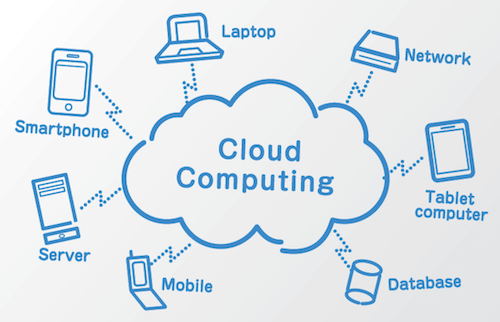The following is a Plus Edition article written by and copyright by Dick Eastman.
The newest technology in computers these days is called “cloud computing.” However, many experienced computer users do not yet understand the term. In fact, "the cloud" can be different things to different people. I thought I would write a three-part article: the first part explains what the cloud is, and the second part will describe using the cloud for genealogy purposes. The third part will address some of the frequently-asked questions (FAQs) concerning the use of cloud computing.
A few years ago, Ancestry.com had outages with its RootsWeb/USGenWeb/WorldConnect web pages. Some users have declared, “So much for the cloud and trusting others with your data.” However, that statement shows a lack of familiarity with cloud computing. While Ancestry uses industrial grade computers as servers to deliver information on the World Wide Web, they obviously are were using cloud computing methods in those days for the affected services that suffered weeks of outage.
NOTE: Most cloud-based services provide 99.999% or better uptime. An article some time ago in Network World at http://goo.gl/YQjLYQ states that “Amazon’s Elastic Compute Cloud (EC2) recorded 2.41 hours of downtime across 20 outages in 2014, meaning it was up and running 99.9974% of the time.” The same article also states, “Perhaps even more eye-catching is the uptime of Google Cloud Platform’s storage service, which experienced 14 minutes of downtime in all of 2014, according to CloudHarmony. That’s good for a 99.9996 uptime percentage.”
Such statistics are common for true cloud-based services running in multiple data centers.
 It is the intent of this article to reduce some of the confusion about the term “cloud computing.”
It is the intent of this article to reduce some of the confusion about the term “cloud computing.”
Computers are marvelous things. We can sit at home with a desktop computer or use a laptop when traveling or even use a handheld computer while sitting in a city park or while riding a commuter train. We can watch YouTube videos, read and write email, check the latest news and weather reports, research a family tree, plot the best travel route to Poughkeepsie, or perform any of dozens of other tasks, regardless of our location. We can do this because we are connected to a monstrous collection of computers and computer accessories that include routers, switches, hubs, and miles and miles of cabling.
In the traditional world of desktop applications, data is usually stored on a computer’s hard drive. In “the old days” of a few years ago, I could go on vacation and leave my computer at home but then could not access my email, photos, or any of my data. In the new world of cloud services, my email and all my data are safely and securely stored online, that is, in the cloud. I can get to it by using a web browser from any computer that’s connected to the Internet. Even better, that information is available to me essentially all the time.
In many cases, I can even get to it from a so-called "smartphone," that is, a cellphone with a built-in computer that usually runs on an Android or Apple operating system.
The hardware that lets us compute anyplace on any device is invisible to us, and most of us do not understand how it all works. However, our computers, even our tiny cell phone "smartphones," are actually plugged into the collective power of thousands of computers that serve all this information to us from far-away computer systems distributed around the world. It’s almost like having a massive supercomputer at your beck and call, thanks to the Internet.
There may be hundreds of thousands of hardware boxes involved along with millions of services available on the Internet. This collection of hardware, software, and data is collectively called "the cloud."
In fact, some people think that any web server that is available on the World Wide Web is part of “the cloud.” However, that impression is incorrect; a web server can be any computer, large or small, that serves up data to the web where people can see it. For instance, some people believe that the web server that is displaying this page to you from http://www.eogn.com/ is a single web server installed in one data center. If that web server stops working at some point, the web page you are reading right now will not be available to you.
Again, that is incorrect. The cloud changed all that.
Definitions are not rigidly defined. The term “cloud” can be taken to mean many different things. However, most data processing professionals will tell you that a single web server installed in a single data center does not qualify as a cloud-based service.
The remainder of this article is reserved for Plus Edition subscribers only. If you have a Plus Edition subscription, you may read the full article at: https://eogn.com/(*)-Plus-Edition-News-Articles/13225059
If you are not yet a Plus Edition subscriber, you can learn more about such subscriptions and even upgrade to a Plus Edition subscription immediately at https://eogn.com/page-18077.